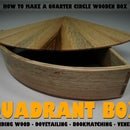Introduction: Make a Natural Whatnot
Whatnot - (noun) Small furniture item used for the display of decorative objects
Naturalistic - (adjective) Appearing as, or resembling, forms in the natural world
Come with me as I describe how to make this naturalistic whatnot, inspired by water lilies and irises.
As usual, a more visually informative video is available to watch alongside this written instructable.
I've entered it into the Furniture contest, so if you like it please remember to vote.
Step 1: Shape Iris Stem and Leaves, and Water Lily Stems
These are all shaped using a draw knife, whittling knives, and 'v' chisel. Aim for realistic shapes, but leave the lower 50mm (2") in the square for easier joint preparation.
The lily stems have a round tenon formed at the top, which is sawn down later to receive a wedge. The tenons terminate through the highest lily pad on the stem. The longer stem passes through the lower lily pad, and will have a short cross peg inserted which supports this lower pad.
The iris stem has a fox-wedged tenon prepared on it's bottom, whilst the iris leaves have sliding dovetails.
Step 2: Sub-Base Preparation
A sub-base is prepared from a secondary wood, and it's function is to hold the elements together at the bottom and make the lily pads at the base appear to float.
Hidden dovetail keys were used to attach the lily pads, but screws from underneath would work equally well (I build the whole whatnot without glue as a challenge)
A mortise for the iris stem, and dovetail sockets for iris leaves are also included in the sub-base
Step 3: Lily Pads and Iris Flower
The lily pads are marked out circular, with those for the base being adjusted to fit the quadrant base shape and intersect each other.
The lily pads for the shelves receive the 'v' notch seen in nature, and also have the stem mortises bored through. Where they contact iris leaves for extra support, a shaped notch is made in the edge. The remaining circumference is beveled and scalloped to give a thin wavy edge .
The iris flower is carefully whittled. The complexity makes it easier to do this in a number of interlocking pieces. The base of the central section is mortised to allow it to sit atop the iris stem.
Step 4: Dry Fit and Final Shaping
The base lily pad sections are fitted to the sub-base, and the edges carved to suggest overlapping (notice the different thicknesses, which were chosen to give an authentic overlap).
Where the lily pads and iris leaves join, two holes are bored at angles to receive square pegs on final assembly. It is crucial to keep checking that the shelves are level with respect to the base.
Step 5: Final Assembly
All the parts are pre-finished, due to the difficulty of doing it after assembly.
The base is re-assembled, iris leaves are installed in the dovetail slots, lily stems inserted, pads added, and the iris stem and flower driven home.
Wedges are driven in to the through round tenons, and the square pegs hammered home. These are all flushed off and given a coat of finish.
Step 6: Completed
Thanks for reading my instructable.
I've entered it into the Furniture contest, so if you like it please remember to vote.
Thanks, Mitch




